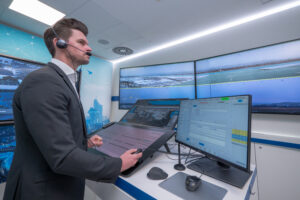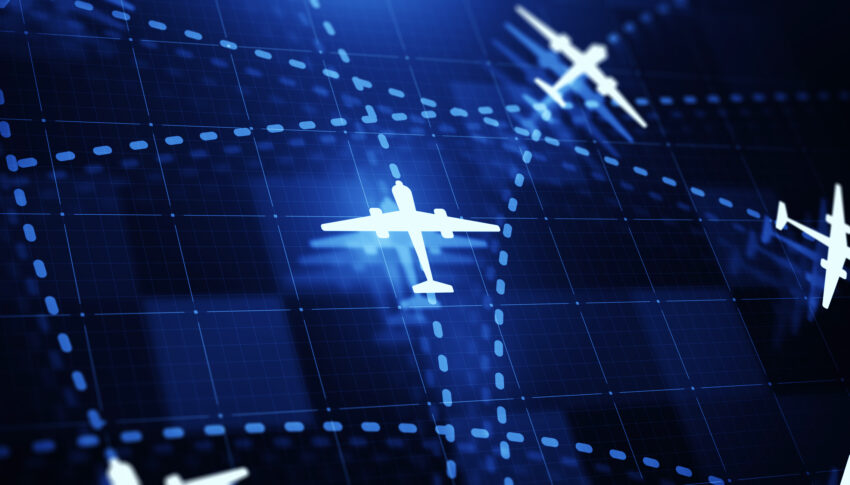Remote digital towers, enabling multiple airfields to be controlled from a single location, are increasingly being used for air traffic management. Bernie Baldwin speaks with leading provider, Frequentis DFS Aerosense, about the challenges and benefits of their deployment.
There is barely any element left in the aviation industry which has not been subject to some level of automation or use of information technology. The move to a ‘next level’ in these fields, through digitalisation and artificial intelligence, is seen by many as being a key to success for the industry’s many stakeholders.
In air traffic management (ATM), there have been high levels of automation and IT for many years. Implementation of these technologies has already brought greater efficiency and/or increased safety to ATM. Among the developments currently attracting the attention of many air navigation service providers (ANSPs) is the use of remote digital towers.
With these, air traffic controllers can be located in control rooms some distance away from an airport. And not only can the controllers oversee one airport remotely, they can handle operations at a number of sites. This capability is seen as the way forward for providing regional and secondary airports with all the required coverage, while being able to reduce costs and obviate the need for additional human resources.
One of the leading providers of remote digital tower operations is Frequentis, which has its headquarters in Vienna, Austria. The company provides ‘communication and information systems for control centres with safety-critical tasks’. Thus, in addition to its role in air traffic management, the company provides its solutions in the area of public safety and transport – police, fire brigades, ambulance services, coastguards, port authorities and railways.

Frequentis Remote Digital Tower
For ANSPs considering the adoption of remote digital towers, a sound rationale for air traffic management operations is needed before any switch is made. Eric Wernsperger, who acts as digital tower solutions expert for Frequentis, and also vice-president of sales for Frequentis DFS Aerosense, describes some of the factors which go into making such a decision.
“The business case for remote digital towers is driven by operational efficiency, cost-effectiveness, and enhanced safety,” he begins. “Firstly, removing the need for a physical tower infrastructure results in substantial cost savings associated with construction, maintenance, and staffing, but it also provides operational benefits and the potential to streamline air traffic control.
“With enhanced digital and automated controller tools, vision is enhanced, and air traffic controller workload can be reduced. Add to this the ability to centralise air traffic control of multiple airports from a single location and it will further optimise resource allocation, streamline operations, and provide redundancy. There are numerous Frequentis systems already operational around the world providing benefits to ANSPs,” Wernsperger explains.
As noted by the Frequentis executive, numerous developments over the years have made the use of remote digital towers an option both technologically and economically. He goes on to pick out the key enablers and the recent developments that are adding to the value of their use.
“Video technology is advancing at a fast pace. Less than twenty years ago, using video technology to replace the out-of-the-window view was absolutely off limits. Today’s video sensors are capable of capturing objects long before they can be seen by the human eye. Paired with today’s data processing capabilities enabled by state-of-the-art information technology, video images can be analysed seamlessly in real time,” Wernsperger reports.
“These enablers can enhance the controller’s situational awareness by pointing out situations of interest, such as detected wildlife activity or uncooperative drones. Further advancements are under way by enriching classical video processing techniques with AI,” he adds.
With a reduction in human involvement and given the distance between the operator and a control tower, systems such as these require some form of extra back-up or fail-safe capabilities. Wernsperger describes the contingencies that are put in place to cover events such as power losses, camera faults and other problems.
“Like each solution that Frequentis designs and delivers for air traffic control, our remote digital tower solutions are fully redundant without any single points of failure,” he declares. “This means that each server, each network switch, each camera and each working position can back up for the other in the event of a failure.
“While switchovers from faulty components to functional ones are performed automatically in the background without interrupting the user, local maintenance staff are informed immediately of the event, and are dispatched to replace the faulty component with a locally stored spare,” Wernsperger continues. “To mitigate the effects of power network glitches, the hardware components are connected not only to the power network, but also to uninterruptible power supplies.”
A reduction in human resources is one of the aforementioned cost savings from the use of remote digital towers. For the air traffic controllers still employed to operate the systems, however, there are a number of ways in which they benefit from the change in working practices.
“Controllers are benefitting from enhanced out-of-the-window view, automated controller tools, combined approach functions and automated tracking/alerts,” notes Wernsperger. “Enhanced situational awareness through video analysis-based alerting features, such as multiple pan tilt zoom (PTZ) camera feeds, allow controllers to monitor multiple aircraft movements simultaneously. Better detection of moving targets in low light conditions also means less ‘heads down’ time due to flight and weather data augmentation.”
There are other advantages for air traffic controllers from having a multi-remote tower environment. In training and certification, for example, personnel can be certified to handle many airports on these digital systems.
The latest technological advantages, better operational efficiency and career benefits for staff, mean that the use of remote digital towers is only likely to increase. Further functions being added to their operation – created through artificial intelligence developments – is almost certain, and will bring greater efficiency and safety to flight operations.
Author: Bernie Baldwin
Published: 10 October 2023




